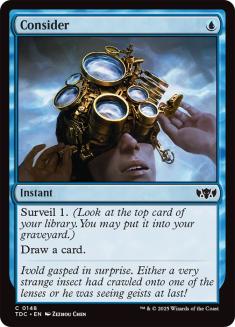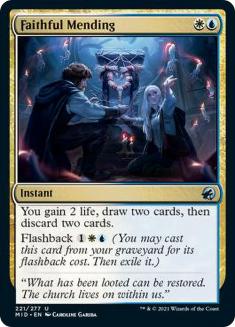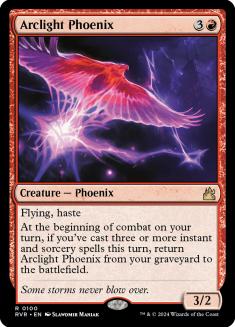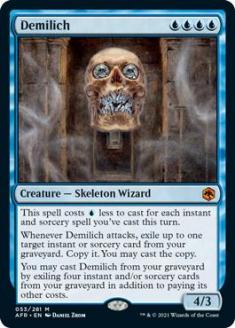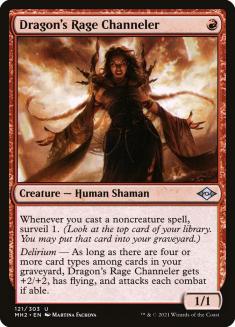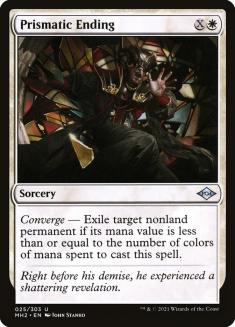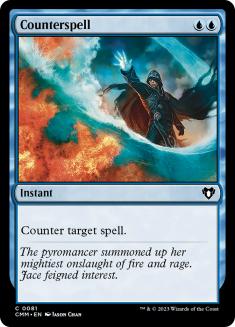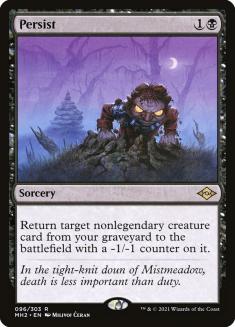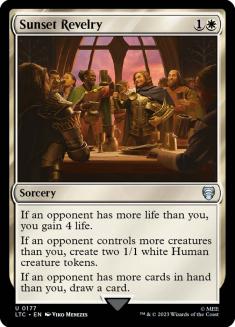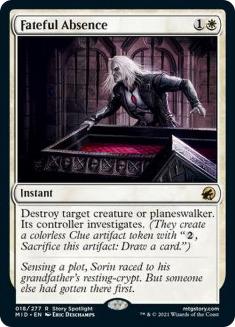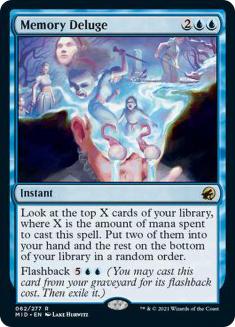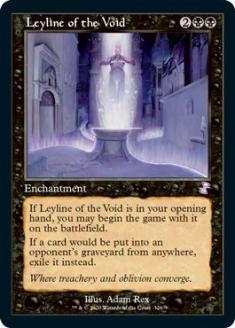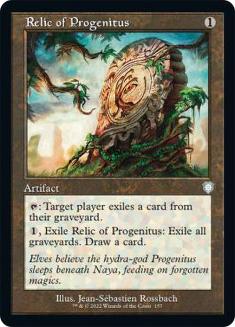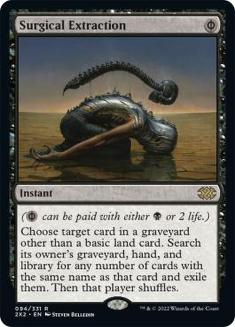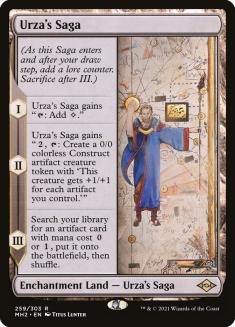It’s hard to give a new set a fair hearing. Strixhaven and Adventures in the Forgotten Realms barely made a mark in Modern; at the other extreme, Modern Horizons 2 predictably and permanently ripped up the format’s foundations. When we had a chance to digest the full spoiler, Innistrad: Midnight Hunt seemed to strike a happy medium and the results this weekend offered promising proof of that.
In keeping with the new rules of engagement set down by Modern Horizons 2, the cheap enablers that put cards in the graveyard were safe bets. Consider is a strict upgrade to Opt for some decks but not much more here. In Historic and especially Pioneer, where there are few or no other cheap cantrips to choose between, Consider is crucial as just another four copies of Opt to give decks like Izzet Phoenix the required density of one-mana spells. Modern players already have access to more cantrips than they can reasonably play between Thought Scour, Sleight of Hand, and Serum Visions, so Consider is merely another member of that roster.
By contrast, Faithful Mending is a unique effect that has the potential to revive old strategies and push new ones over the line.
Creatures (8)
Lands (17)
Spells (35)
- 4 Lightning Bolt
- 4 Serum Visions
- 4 Manamorphose
- 3 Gut Shot
- 4 Thought Scour
- 4 Prismatic Ending
- 4 Faithless Salvaging
- 4 Consider
- 4 Faithful Mending
Sideboard

Players who have been yearning to bring back Arclight Phoenix ever since the Faithless Looting ban got a glimmer of hope this weekend thanks to (who else?) aspiringspike. Faithful Mending is certainly no Faithless Looting – costing two prevents the nut draws that let Izzet Phoenix take an aggressive stance when it was dominant in Modern and makes it harder to build around former threats like Thing in the Ice – but it’s a strong enough replacement to make the strategy worth revisiting even at the cost of splashing another colour.
Demilich is finally delivering on the hype around it from a few months ago, edging out the many other spells-matter creatures as this deck’s secondary threat. This choice also acknowledges that Jeskai Phoenix can’t be built for raw speed now – barring a double Manamorphose draw, Demilich is being cast on Turn 3 at the earliest and attacking on Turn 4 – but can lean into its recursive threats. This is crucial for a deck that lacks any conventional source of card advantage and which is actively throwing cards away to Faithful Mending or Faithless Salvaging; trading a normal threat for a removal spell is a bad deal in that context, while discarding Demilich and recasting it immediately lets you recoup some of that loss.
This answers the most common question asked in Twitch chat this past weekend – surely this deck wants Dragon’s Rage Channeler?! The card seems like a natural fit – and is so strong that it’s probably worth it as an unnatural one – but its absence makes sense. Channeler is a lightning rod for the Unholy Heats and Prismatic Endings that have become the go-to removal in Modern, and without its partner-in-crime in Ragavan, Nimble Pilferer or other aggressive threats, it’s hard for Channeler to speed up your clock by a meaningful amount.
This question prompts another – what would you cut? The deck needs a high density of one-mana spells for Arclight Phoenix and the most marginal two-mana spell in Faithless Salvaging is a much-needed discard outlet for Phoenix. Running seventeen lands (including a Sacred Foundry that can’t cast most of your spells) is already playing with fire. Prismatic Ending is the most optional card on paper, but that kind of broad answer is what lets you play this slower game and you are much weaker to Chalice of the Void (a more common maindeck card than ever before) and Rest in Peace without it. If graveyard hate does pick up as a response to these results, Channeler leaves you even more exposed to that.
Maybe Channeler isn’t the answer but the deck’s low threat count is still an issue. Jeskai Phoenix gains a lot from Prismatic Ending almost entirely replacing Path to Exile – one is a lot better at hitting four-drops! – but the slower white decks in Modern feature at least one of Chalice of the Void and Solitude so that issue is still there. This list only has eight total threats and a single Arclight Phoenix is unlikely to cross the finish line by itself, so anything that can exile your threats from the graveyard or battlefield is a problem.
These structural flaws have no clear answers and leave me sceptical about the deck’s future but it’s nice to know that Arclight Phoenix can still shine in Modern.
Another retooled aspiringspike deck found success in the hands of another Modern innovator with the help of Faithful Mending:
Creatures (5)
Planeswalkers (3)
Lands (23)
Spells (29)

The Reanimator package from Modern Horizons 2 can be the focus of a dedicated combo deck or the big finish in a combo-control deck, but both approaches lacked good discard outlets to get your Persist targets out of your hand when you can’t deposit them there directly via Unmarked Grave. You can Thoughtseize yourself – and your fastest draws require this – but Thoughtseize is the most important card for fighting through the interaction and graveyard hate that’s sure to be more popular after this weekend.
Incidental discard outlets like Collective Brutality or Liliana of the Veil have aged poorly; you want a cheap enabler that does the job properly. Faithful Mending sets up a Turn 3 Persist with in-built insurance against the common approach of stranding the Reanimator deck with a useless hand by discarding or countering the graveyard enabler. The life buffer makes it easier to justify taking one or two turns off to sift through cards looking for Persist or protection for it.
Faithful Mending pairs well with reactive cards like Counterspell in not just the obvious way but also in enabling more conditional interaction. Thoughtseize and Counterspell are the most universal versions of their effects by definition but are still poor draws against empty or weak hands and on-board pressure respectively. Early prototypes of this deck featured maindeck Chalice of the Void, your best possible card in many matchups or situations and totally dead in others. It’s easier to load up on cards like this when you can trade them for something new.
Despite this, there are good reasons why you rarely see Thoughtseize and Counterspell together and those still apply here. Counterspell forces a choice between furthering your development with Unmarked Grave and sorcery-speed interaction like Prismatic Ending and Teferi, Time Raveler or holding up interaction. It also places tough demands on your manabase; you will want often want to fetch basic Swamp to mitigate the life loss from Thoughtseize, but the possibility of needing UU makes that tricky and drawing the basic Swamp or Plains naturally will often be a disaster.
This version of Esper Reanimator has a problem fans of the blue Scapeshift decks of past Modern eras will recognize: you can make favourable exchanges, line up your interaction properly, and prolong the game, but you ultimately do need to find and resolve your four-of combo piece to win. Unmarked Grave for Unburial Rites offers a theoretical redundancy here but one that’s hard to realize under pressure. With Scapeshift, resolving your namesake usually won the game immediately; here, there’s a big difference between Archon of Cruelty on Turn 3 versus Turn 6 (especially in a matchup where Serra’s Emissary won’t lock up the game by itself instead).
I think the next step for Esper Reanimator involves picking a lane and staying there – a proactive approach with more black disruption and Priest of Fell Rites that aims to combo quickly (with Priest also offering uncounterable reanimation in longer games where its steep life payment is more palatable thanks to Faithful Mending) or a reactive approach that revisits Gifts Ungiven for Unburial Rites and your preferred reanimation target as a ‘one-card combo’ that’s glacially slow in current Modern but more attainable when you can threaten a fast Persist much of the time and have strong delaying tactics otherwise.
Pure control was already becoming increasingly successful in Modern and received several upgrades with this trip to Innistrad.
Sunset Revelry has most of the upside of Timely Reinforcements where that card is good (and in those matchups efficiency is crucial so the gap between two mana and three is even bigger than normal) but can often be converted into a card elsewhere. In particular, Revelry lines up perfectly against Ragavan, Nimble Pilferer.
Fateful Absence is a welcome instant-speed answer for creatures that doesn’t clash with Chalice of the Void on one (its usual setting in matchups where you need to remove creatures early and often) and is the cleanest answer to the omnipresent Teferi, Time Raveler as well as Teferi, Hero of Dominaria or Wrenn and Six.
With cheap threats and Unholy Heat making planeswalkers harder to defend and the pair of Counterspell and Archmage’s Charm giving you reasons to hold up mana, control decks are in the market for traditional sources of card advantage. Fact or Fiction, the most traditional option of all, does the job, but the base rate on Memory Deluge is roughly as powerful without other graveyard synergies like Mystic Sanctuary or Uro, Titan of Nature’s Wrath, and flashing it back puts the game away once you have it under control.
You don’t need me to explain why graveyard hate is good against Reanimator but the details matter here. Since Modern Horizons 2 the format has been in a curious place where hard graveyard hate like Rest in Peace is more common than soft hate like Surgical Extraction.
The Cascade decks need their hate to cost three or more, which pushes out cheaper but softer hate and encourages hard hate that’s free in practice like Leyline of the Void and Endurance. Specifically, Living End wants some amount of graveyard hate to break the symmetry on its namesake and its success encourages others to play hard hate as Living End can rebuild from a single Soul-Guide Lantern or similar. Graveyard hate is potent against Dragon’s Rage Channeler and Unholy Heat, but Channeler can easily get you back to delirium after one-shot hate whereas Rest in Peace or Leyline can shrink it permanently (while disabling Murktide Regent or Lurrus of the Dream-Den).
Meanwhile, any Urza’s Saga deck gets maindeck access to graveyard hate but from a narrower band of options. When Mono-White Hammer (Lurrus) was the most popular Saga deck and consensus best deck, the litmus test for any graveyard strategy was how weak you were to Sanctifier en-Vec in post-sideboard games. Endurance is a staple of not just Five-Color Elementals, as you’d expect, but any deck with enough green cards. Surgical Extraction is brutally effective against both Jeskai Phoenix and Esper Reanimator but has largely disappeared from Modern outside its natural home in Dimir Mill (Lurrus), as it didn’t accomplish much against the previous crop of graveyard decks without other support.
It’s an encouraging sign for these new contenders that they were able to flourish, however briefly, in a format that was both incidentally and intentionally rife with graveyard hate. It’s worth focusing on the hate that’s also relevant against the other big winner featured here in Azorius Control as well as in the format at large:
Endurance was already a popular card outside this context for its strength against the Dragon’s Rage Channeler decks. It lines up perfectly against Channeler, shrinking it and eating it after it’s forced to attack, but it’s also an ideal response to Ragavan (which can win games by itself and shrugs off graveyard hate) as a sudden blocker that survives Lightning Bolt (or Unholy Heat once the graveyard is gone).
Less obviously, it’s surprisingly strong against control as an instant-speed threat that pressures planeswalkers and lets you hold up other interaction. This scrappy aggro-control game is a common fallback plan for decks that may be outmatched on raw card quality against control and Endurance is a key part of that. With Prismatic Ending replacing other removal, these decks have a lot of trouble actually removing Endurance without spending a lot of mana, often on their own turn.
With Endurance lining up so well against many of the proactive, reactive, and linear decks of the format, being able to lean on Endurance, even in the maindeck, is a big draw to a Modern deck right now. Elementals is a natural candidate, as is creature combo like Golgari Yawgmoth. Gabriel Nassif, who has piloted both Living End and various control decks to sustained success in recent Modern Challenges on Magic Online, highlighted finding a control shell with Endurance as his goal and mentioned Wilderness Reclamation (the perfect partner for Memory Deluge) as a possibility. Other old favourites like Five-Color Bring to Light or Five-Color Niv-Mizzet that naturally have a high green card count may want to explore this too.
The floor on Urza’s Saga is incredibly high but its stock improves considerably when the final chapter can find silver bullets to shut down linear decks. Consistent access to graveyard hate at the cost of one slot lets you improve a vast swathe of matchups with little effort. It also supports your other interaction well; the Construct tokens apply pressure to force the opponent to play into reactive cards and give them less time to recover from Thoughtseize or answer the hate card the final chapter will find.
Meanwhile, Urza’s Saga is one of the best cards in Modern against control – to such an extent that Spreading Seas has made a glorious comeback as a cheap, unconditional answer – and is worth a consideration as a win condition for control decks as we saw in the early days of Modern Horizons 2, especially if mirrors will be more popular.
Innistrad: Midnight Hunt is making itself heard in a format that had just about settled into a new identity. As Modern reacts to these new changes, it will hopefully remain dynamic for a while to come.


